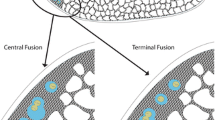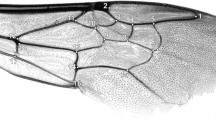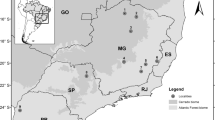Abstract
The presence of both triploid males and females in Bombus terrestris was detected by distinct chromosome observation. These cytological features are novel among the higher Hymenopteran insects. We thus strictly applied the complementary sex determination (CSD) model previously proposed for Hymenopteran insects.
Three out of 60 sibling queens that were mated with diploid males produced both triploid males and females, and founded colonies. The male to female ratio of the bees which emerged from the fertilized eggs of the queens was approximately 1 to 1. Thus we reconfirm that the sex in B. terrestris is determined by a single multi-allelic locus.
The body size of the triploid males was smaller than that of the diploid and haploid males. We found hatched eggs laid by one triploid female (worker). One of these developed into a 3rd instar larva, however most of the triploid individuals were sterile.
Similar content being viewed by others
References
Beye M, Moritz RFA (1996) Mapping the sex locus of the honeybee (Apis mellifera). Naturwissenschaften 83: 424-426.
Beye M, Hunt GJ, Page RE, Fondrk MK, Grohmann L, Moritz RFA (1999) Unusually high recombination rate detected in the sex locus region of the honey bee (Apis mellifera). Genetics 153: 1701-1708.
Beye M, Hasselmann M, Fondrk MK, Page RE, Omholt SW (2003) The gene csd is the primary signal for sexual development in the honeybee and encodes an SR-Type protein. Cell 114: 419-429.
Buttermore RE, Pomeroy N, Hobson W, Semmens T, Hart R (1998) Assessment of the genetic base of Tasmanian bumble bees (Bombus terrestris) for development as pollination agents. J Apicult Res 37: 23-25.
Camargo CA (1979) Sex determination in bees. XI. Production of diploid males and sex determination in Melipona quadrifasciata (Hymenoptera, Apida). J Apic Res 18: 77-84.
Duchateau MJ, Hoshiba H, Velthuis HHW (1994) Diploid males in the bumble bee Bombus terrestris: Sex determination, sex alleles and viability. Entomol Exp Appl 71: 263-269.
Duchateau MJ, Mariën J (1995) Sexual biology of haploid and diploid males in the bumble bee Bombus terrestris. Insects Soc 42: 255-266.
Gadau J, Gerloff CU, Krüger N et al. (2001) A linkage analysis of sex determination in Bombus terrestris (L.) (Hymenoptera: Apidae). Heredity 87: 234-242.
Garófalo CA, Kerr WE (1975) Sex determination in bees. I. Balance between femaleness and maleness genes in Bombus atratus Franklin (Hymenoptera, Apidae). Genetica 45: 203-209.
Hasselmann M, Fondrk MK, Page RE, Beye M (2001) Fine scale mapping in the sex locus region of the honey bee (Apis mellifera). Insect Mol Biol 10: 605-608.
Hoshiba H, Kusanagi A (1978) Karyological study of honeybee. J Apic Res 17: 105-109.
Hoshiba H, Okada I, Kusanagi A (1981) Diploid drone of Apis cerana japonica and its chromosomes. J Apic Res 20: 143-147.
Hoshiba H, Duchateau MJ, Velthuis HHW (1995) Diploid males in the bumble bee Bombus terrestris (Hymenoptera) karyotype analyses of diploid females, diploid males and haploid males. Jpn J Entomol 63: 203-207.
Hunt GJ, Page RE (1994) Linkage analysis of sex determination in the honey bee (Apis mellifera). Mol Gen Genet 244: 512-518.
Imai HT, Taylor RW, Crosland MWJ, Crozier RH (1988) Modes of spontaneous chromosomal mutation and karyotype evolution in ants with reference to the minimum interaction hypothesis. Jpn J Genet 63: 159-185.
Naito T, Suzuki H (1991) Sex determination in the Sawfly, Athalia rosae ruficornis (Hymenoptera): Occurrence of triploid males. J Hered 82: 101-104.
Ono M, Mitsuhata M, Sasaki M (1994) Use of introduced Bombus terrestris worker helpers for rapid development of Japanese native B. hypocrite colonies (Hymenoptera: Apidae). Appl Entomol Zool 29: 413-419.
Ross KG, Fletcher DJC (1985) Genetic origin of male diploidy in the fire ant, Solenopsis invicta (Hymenoptera: Formicidae), and its evolutionary significance. Evolution 39: 888-903.
Speicher BR, Speicher KG (1940) The occurrence of diploid males in Habrobracon brevicornis. Am Nat 74: 379-382.
Smith SG, Wallace DR (1971) Allelic sex determination in a lower hymenopteran, Neodiprion nigroscutum Midd. Can J Genet Cytol 13: 617-621.
Whiting PW (1943) Multiple alleles in complementary sex determination of Habrobracon. Genetics 28: 365-382.
Whiting AR (1961) Genetics of Habrobracon. Adv Genet 10: 333-406.
Woyke J (1969) A method of rearing diploid drones in a honeybee colony. J Apic Res 8: 65-74.
Woyke J (1986) Sex determination. In: T. E. Rinderer, ed. Bee Genetics and Breeding. London: Academic Press, pp 91-119.
Author information
Authors and Affiliations
Corresponding author
Rights and permissions
About this article
Cite this article
Ayabe, T., Hoshiba, H. & Ono, M. Cytological evidence for triploid males and females in the bumblebee, Bombus terrestris . Chromosome Res 12, 215–223 (2004). https://doi.org/10.1023/B:CHRO.0000021880.83639.4b
Issue Date:
DOI: https://doi.org/10.1023/B:CHRO.0000021880.83639.4b




